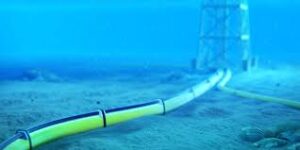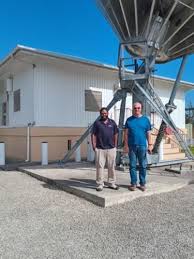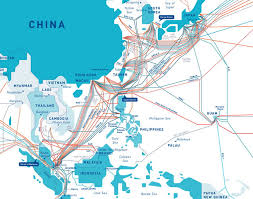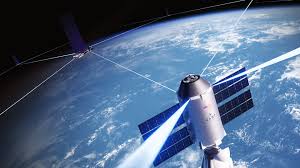Submarine Internet Cables & Digital Export
The arrival of submarine cables that brought high-speed internet to Africa had a significant impact on firm productivity, exports and job creation especially in higher skill set occupations. Pakistan’s digital exports for the fiscal ending June 2025 are in the range of $ 3.5 billion (PKR 250 million month average ). Pakistan however lags comparators in terms of its digital infrastructure. Digital connectivity can greatly assist in achieving the 6 outcomes of the new World Bank Pakistan Country Partnership Framework . The contribution of the digital economy to Pakistan’s economic growth remains incipient accounting for just 3 % of GDP in fiscal year ending June 2024 . Digitally delivered exports have increased to around 10 % of total exports, yet Pakistan’s share in globally delivered digital exports remains low at just 0.1 percent.
Arrival of Submarine Internet Cables
 Credit;Telecom Review Asia
Credit;Telecom Review Asia
The arrival of submarine cables that brought high-speed internet to Africa had a significant impact on firm productivity, exports and job creation, especially in higher skill set occupations. Nationwide internet access remains low with only 33 % of the population reporting using the internet in 2022. Additionally, Pakistan has the third-largest broadband usage gap in the world, with 140 million people living within the range of mobile broadband networks but not using the internet. Almost 17 p% of the population lives beyond the coverage of mobile broadband networks and coverage gaps in Pakistan are highest in South Asia. Both 3G and 4G mobile population coverage in Pakistan, at 74.9 % and 83.6 % respectively, are below South Asia’s regional average of 88.1 % and 90.9 % respectively. The 4G is the dominant technology, accounting for two-thirds of the total mobile connections however, around 1/3 of mobile users are still on legacy 2G networks. In addition, Pakistan is one of the three countries in the region where 5G coverage is not available due to limited availability of fiber optic networks, low tower density and a lack of feasible use cases. The efficacy of the Universal Services Fund (USF) is disheartening in this perspective.
Pacific Islands 2 Subsea Internet Cables – Pakistan’s 5
A local Vunuatu tech company Prima Limited and the Asian Development Bank (ADB) signed a debt-plus-grant mandate agreement in January 2025 for financing of the ‘Tamtam’ cable, Vanuatu’s second subsea fibre optic cable. Prima is a local tech company responsible for managing the operations of the existing subsea cable (ICN1) and the Tamtam cable will be owned and operated by Prima. The subsea internet cable ” Tamtam ” will connect Port Vila and supply global bandwidth to Vanuatu , a relatively small island in the Pacific, providing vital backup in the case of a disruption to the existing subsea cable that connects Vanuatu through Fiji . In the perspective of Vanuatu’s susceptibility to natural disaster redundancy is now in place moreover, the second cable will enhance local technology capability and advance Vanuatu’s place in the global ICT industry, diversify its economy and attract investment in emerging sectors such as data storage. This endeavour is an integral component of United Nations-led Science Monitoring And Reliable Telecommunications (SMART) Subsea Cables initiative. The Tamtam cable will be equipped with innovative sensors that can provide insights into the state of the ocean to monitor climate change, including ocean heat content, circulation and sea level rise, which may provide early warning for earthquakes and tsunamis, and monitor seismic activity for earth structure and related hazards. Even submarine stealth activity can be monitored and the West has acknowledged the dire need for increased investment in submarine cable infrastructure across the Pacific, including Vanuatu, Papua New Guinea and Solomon Islands. These island countries are perceived as being of strategic significance in the face of rising Chinese influence in the region.
A French company Alcatel has been contracted to carry out the marine cable deployment and connection, with the cable expected to be completed and operational by the end of 2026. The ADB credit committee has approved the financing facility for the cable, subject to final approval by the ADB board. Overall funding for the project will total USD 26.8 million . The SMART part of this unique subsea internet cable is entirely funded by the French government of an amount of almost 18 million euros (2,3 billion vatus).

Gender Gap & Financial Inclusion
Pakistan faces a 38 % gender gap in mobile phone ownership and mobile internet adoption and a 49 % gender gap in smartphone adoption in 2021 perhaps the largest gap in South Asian region . Although 53 % of women report owning mobile phones, nearly half of women mobile phone owners do not regularly use mobile internet, and only 27 % use it daily . The State Bank of Pakistan, in collaboration with the Asian Development Bank , launched the WE Finance Code Pakistan in July 2025. The WE Finance Code is a World Bank led initiative to improve access to finance to women and women owned businesses in Pakistan. The Code was signed by 20 banks of Pakistan reflecting a corporate financial commitment towards women’s financial inclusion.
Indus River IT Route
 Credit;Submarine Networks
Credit;Submarine Networks
Inadequate fixed broadband infrastructure is a key constraint on Pakistan’s national backbone infrastructure exhibiting significant concentration along primary transport corridors along the Indus River, connecting the country’s northern and southern regions. Security concerns in western provinces have further limited the construction of additional broadband infrastructure. Some internet service providers (ISPs) have established nationwide fiber networks due to challenges in securing right-of-way (RoW) permissions from various stakeholders essential for deployment of critical IT infrastructure. Consequently, Pakistan Telecommunications Company Limited (PTCL) maintains the only comprehensive nationwide connectivity infrastructure, creating dependency among smaller ISPs that rely on this dominant network.
Flooding
Disruptions along the north-south corridor resulted in significant disruptions to internet access within the country in the year 2022 when floods led to multiple cuts along the country’s IT backbone. Such challenges have downstream effects on quality, measured in download speeds , and costs of fixed and mobile broadband in the country.
Speed
Pakistan has one of the lowest average fixed and mobile broadband
speeds within the South Asian region. Average fixed broadband speeds
are 16 Mbps in Pakistan being third lowest in the region. Average mobile broadband speeds are 20 Mbps also third lowest in the region
. Fixed broadband speeds also vary across geographical districts with Karachi and Islamabad experiencing average speeds that are twice the speeds experienced in the median districts . The current rate of fixed broadband deployments has plateaued and it is estimated that at this pace it could take approximately 3 decades for Pakistan to reach fixed broadband connectivity levels comparable to those of high income countries.
IFC Fiberization
According to a recent study by the International Finance Corporation (IFC) Pakistan lags a benchmark group of countries namely Bangladesh, Egypt, India, Indonesia and the Philippines by approximately 5.1 million Fiber-to-the-Home (FTTH) lines. To close this gap by 50 % by the year 2027 an average investment of US$ 2.5 billion in fixed broadband is required. Although fiber deployment is capital expenditure intensive, it remains a future-proof solution for high-bandwidth backhauling, which is essential for future 5G deployment.
Satellite Technologies
 Credit;SpaceNews
Credit;SpaceNews
Despite availability of satellite services, fiberization will continue to be a fundamental prerequisite for enhancing mobile broadband services across the country regardless of the last-mile technology used. Satellite technologies are a viable and complementary option for expanding connectivity to remote areas . Satellite technology can serve as a crucial complement to fixed broadband infrastructure, playing a vital role in bridging the digital divide particularly underserved areas. Satellite broadband uses low orbit satellites to provide connectivity rather than traditional wired infrastructure such as fiber or cable. Fixed broadband, particularly fiber, remains the backbone of high-speed, high-capacity, and future-proof connectivity, essential for long-term digital growth and technologies such as 5G. Despite this, satellite connectivity can complement fixed broadband infrastructure by providing connectivity to areas where laying fiber connections would be exceptionally cost-prohibitive or logistically challenging. It can enhance last-mile access, support emergency and disaster recovery communication and ensure digital inclusion, particularly for rural and remote areas.
Digital Payments System & IT Exports
Pakistan has gained prominence as one of the few countries in the region to have a fully interoperable fast payments system, RAAST (operated by the SBP). Currently, RAAST handles a daily average of 3 million transactions, with a total daily value of approximately PKR 51 billion (US$ 170 million), which are largely person-to-person (P2P).
The State Bank of Pakistan (SBP) raised the permissible retention limit in Exporters’ Specialized Foreign Currency Accounts (ESFCAs) from 35% to 50%. Exporters are now allowed to make equity investments abroad using proceeds from these accounts allowing IT exporters to acquire shareholding in offshore entities using up to half of their foreign earnings. Further, the usage of the balances available in the ESFCAs has been simplified by allowing the IT exporters to make their payments from these accounts without any approval from SBP or banks.
Freelancer
A new Framework for Freelancers has been introduced to further ease the opening of their bank accounts and allow higher retention of amounts in their foreign currency (FCY) accounts. Freelancers will now be able to open bank accounts both digitally and physically at their choice with minimum documentation requirements and ESFCAs shall be opened concurrently with the opening of their primary PKR account. The freelancers can retain 50% of their export proceeds or USD 5,000/- per month whichever is higher, in their ESFCAs and can make all payments from these accounts without any approval from SBP or banks. The exporters should be registered with Pakistan Software Export Board (PSEB) or Pakistan Software Houses Association (P@SHA), and involved in the export of Software, Information Technology (IT) services or IT Enabled Services (ITeS).
Arabian Sea Submarine Internet Cable
 Credit;RFI
Credit;RFI
Submarine Internet Cables & Digital Export
Pakistan has a unique advantage that it can offer its Northern areas , mostly snowbound and with freezing temperatures, as digital data storage centers and hubs and attract huge and strategic digital investment . Pakistan needs to refocus , invest , upgrade its Arabian Sea submarine internet cable grid along its entire coastline and transform into a regional internet hub.This should enhance its technology and digital export and bring in sorely required forex. The time for placency may be over.
Author ; Nadir Mumtaz
Trademark Blue Economy IPO-PK

Credit;
https://www.sbp.org.pk/epd/2023/FECL17.htm
https://www.sbp.org.pk/press/2023/Pr-23-Oct-2023-1.pdf
https://www.lowyinstitute.org/the-interpreter/vanuatu-s-digital-vulnerability

Leave A Comment